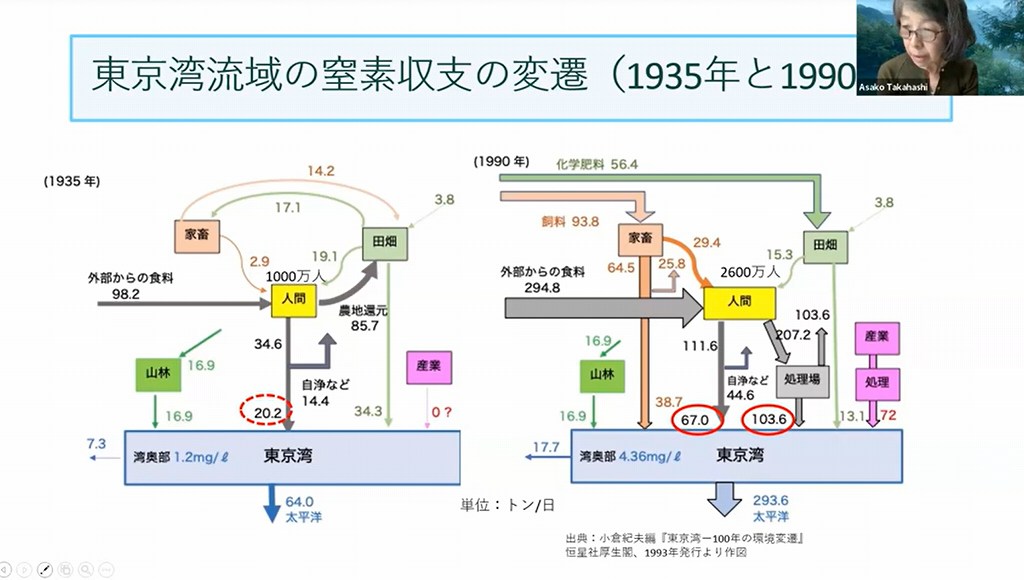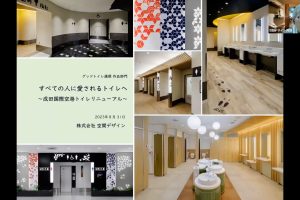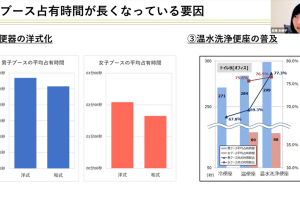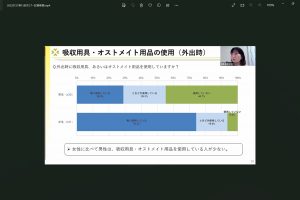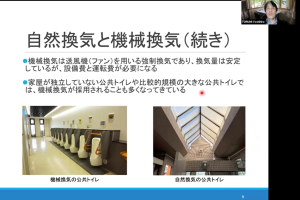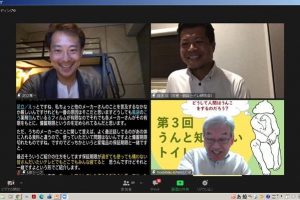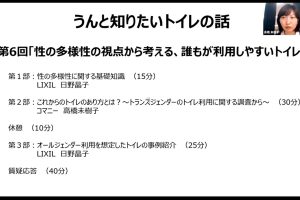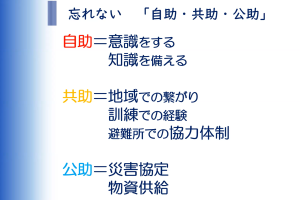The 25th seminar
“SDGs and Toilet” -2, From the pump toilets to the flush toilets and beyond
– “Evolving Toilets” book series, volume 3 “SDGs and Toilet” edited by Japan Toilet Association
Japan Toilet Association (JTA) Seminar Series; “Let us know more about our Toilet Story”
Date: 22 June 2023 (Thu) 18:00-20:00 JST
Presenters:
Lecturer 1; Mr. Kohei Yamamoto (Dynax Urban Environment Research Institute, JTA steering committee member)
“Are flush toilets sustainable?”
Lecturer 2; Ms. Asako Takahashi (NPO Rainwater Citizen’s Association)
“What is a sustainable toilet from the water environment?”
Lecturer: Mr. Kohei Yamamoto
1. Are the flush toilets sustainable?
Today, I will talk about the era of the pumping toilets in the first half part, and then talk about toilet issues from the water resources in the latter half part.
There are three volumes in the “Evolving Toilet” series published by the Japan Toilet Association (JTA), where I edited the entire SDGs volume. The first half of the book talks about the matters in the developing countries and the gender issues. The latter half talks about the sewage and water resource issues.
I work as the environmental and disaster prevention consultant in Dynax Urban Environment Research Institute as a representative. I am a starting member of JTA and served as the secretary general for 10 years. I was involved in the early days of Japanese innovative toilets. Ms. Asako Takahashi will speak after me, and she works in NPO Rainwater Citizen’s Association.
1.1 The pumping toilet
Almost of all Japanese toilets are the flush types now, and less than 5% are non-flush ones. Some non-flushing toilets include a simple flush system, which stores the excrement in a toilet tank with just one cup water. There is almost non-existent straight to see the filth. The flush toilets have become more popular with the spread of the sewage systems since late 1970s in Japan. In the old days, people used to buy toilet tickets from the municipal office and had the toilets pumped out by a disposal company or the city staff about once a month.
The vacuum lorries were used to pump up the excrement in the late 1970s. Before that, the work was scooping the excrement into a barrel and carrying it to a tank on the back of a special lorry. A book titled “Japanese-European Culture Comparison” written by Louis Frois who was a Portuguese Catholic priest and missionary (1532-1597) informed the excrement and urine were highly valued in medieval age in Japan. They paid or offered rice to the workers who collected the excreta. The fertilizer, which was made by ripening the excreta, was extremely valuable as a quick effective nitrogen fertilizer, and was used as a fertilizer from a long time ago until soon after World War II.
Edo, name of the old Tokyo, was a metropolis with one million people, but it was extremely clean city compared to European cities. The reason is that there was a running water supply, and the excreta were collected from the city and used as a fertilizer for the farmers in the suburbs. The manure was purchased by the farmers and provided income to the landlord of the tenement house. We are talking about a circular economy now, but the excrement had value as a resource and used as an economy then. The first sewer system was built in Yokohama in 1869. The sewers carried the rainwater and the messy drainage.
After the medieval Japan ended, its isolation policy against the foreign countries and opened its ports, the infectious diseases severely spread in Tokyo and Yokohama area. The Kanda sewer system in Tokyo was completed to protect the public health in 1884. The excrement was still used as a fertilizer during the Meiji period (1868-1912). However, as Tokyo’s population increased, it became oversupplied. In the past, the farmers paid money to pump out the excrement, but gradually it changed to the opposite position where the farmers were to be paid money to collect it. Instead of being a resource, it has turned into a waste that costs money to dispose of.
There was a problem where the collectors would only go to places where they could make a profit or where it was easy to pump the excrement and would not go to further locations. Many problems often occurred with the devious contractors, such as not transporting the excrements to the farmland but dumping it on the way.
In 1900, the Sewage Cleaning Law and the Sewage Law were enacted against the backdrop of the cholera epidemic. Here, the filth is mainly the excrement and urine. Currently, they are included in general waste along with garbage and bulky waste under the Waste Management Law.
The Sewage Cleaning Law enacted and the municipalities were responsible for disposing of the excrement and urinate, which had previously been processed by the private sector. By the enactment of the Sewerage Law, a sewerage plan was formulated for Tokyo in 1908. There was no sewage treatment plant, and the sewage system was designed to discharge rainwater and the messy drainage to the rivers and the public water areas.
The first public toilet in Japan must be “Roadside Toilet” built in Yokohama, where was a port to be opened to overseas markets in the early Meiji period. They built 63 European style toilet buildings and toilet bowls were wooden crouching style. The Nobi Earthquake occurred in 1891, many people, especially in the Tokai region, replaced the ceramic toilets in the recovery efforts. At that time, the dyed blue patterned toilet bowls became popular and spread throughout Japan.
The parasites became a huge problem in the Taisho era (1912-1926) in Japan. When conscript tests were conducted in the military, it was discovered that a very high percentage of people had parasites. Especially in rural areas, there were many parasite carriers. The parasite disease will lead to weak health. Therefore, Ministry of the Interior has developed an improved toilet tank. This method was that the excrement was rotten in a toilet tank for about three months, and extinct the parasite eggs.
Basically, the main method of processing the excrement and urinate was to utilize it as a fertilizer, and there were no other methods to process it. Tokyo’s population increased and the suburbs were expanded. Then it became necessary to carry the excrement to the distant farmlands, and this began to be transported by the rail.
The excrements were still used as a quick effective nitrogen fertilizer for a while after World War II. However, the utilize was prohibited by order of Allied Forces General Headquarters (GHQ) and then the disposal of the excrement became a huge problem.
The excrement was reluctantly loaded up to the ships in Tokyo, and dumped it into the ocean far off the coast of Tokyo Bay. It was banned by the London Convention (1972) which aims to prevent the marine pollution. The dumping into the ocean stopped after the enactment of the Marine Pollution Prevention Act in 2007. The excrement treatment technology has been developed, and the plants were gradually constructed after World War II.
1.2 The flush toilet
The flush toilets became popular in the housing complexes. Japan Housing Corporation was established in 1955, because there was a serious housing shortage. To solve this matter, many stacked housing complexes were built mainly in urban areas. It was not possible to build a pumping toilet, because the building was a stacked housing complex, then the flush toilets were installed. The system was to put the excrement into a communal septic tank and to undergo some treatment before being discharged.
The original toilets were crouching style toilets. It was placed on a step higher floor and men standing on the lower floor behind the toilet. The sitting style toilets were adopted after 1958, when this type of the toilets in Japan began to be common. However, total excrement was not properly disposed. The flush toilet came first and its processing system followed.
Because the sewage system was not sufficiently developed, a septic tank only processed the excrement. The septic tank together with a flush toilet became popular in the private houses in Japan. The septic tank only treated the excrement from the flush toilets. The other the messy drainage from the kitchen, laundry, bathrooms, etc. was drained into the sewer untreated. The purification capacity of a single treatment of the septic tank was low performance, and brought the water pollution in rivers and lakes became a serious problem.
To solve this situation, Septic Tank Law was revised in 2000. It prohibits single-processing septic tanks and introducing a combined processing septic tank that processes the excrement and the messy drainage together. The combined processing septic tank has a high treatment performance and can process the liquids into almost the same level as the specialized sewage processing plant. 15.3% of the excrement was processed by the public sewers in 1974, but 76.1% of it was done by them in 2019.
The processing by the septic tanks accounted for 14.2% in 1974 and 19.3% in 2019. 70.6% of the population used the pump toilets in 1974, but it decreased to 47.9% in 1979, and 4.6% in 2019. The flushing toilet covering rate was 9.2% in 1963, 45.9% in 1978, 83% in 1999, and 94.5% in 2017. It can be seen the flushing toilets are taking over steadily. On the other hand, the users of the non-flushing rate are steadily decreasing, from 36% in 1989, 9% in 2008 and 4% in 2021.
The toilet comfort has much improved by means of the progress of the flush toilets with the sitting style toilets. According to the 2008 Housing and Land Statistics Survey, 90.7% of the total number of houses installed the flush toilets, and 89.6% did the sitting style toilets. The website of the Restroom Industry Association informs the penetration rate of the warm toilet seats in homes reached 80.3% in 2021.
The flushing toilets became much more common after World War II. However, the sewage processing facilities could not keep up, and provoked the pollution of the rivers, lakes, and seas. Since the 1980s, the sewerage systems have been gradually improved. Now the toilet drainage is no longer a major source of pollution.
1.3 Toilet issues considered from the perspective of the water resources
Japan is called to be blessed with the water, and its annual rainfall is about 1.4 times more than the world average. However, the total annual precipitation per person in Japan is 5,000 cubic meters, which is about one-fourth of the world’s precipitation of about 20,000 cubic meters. The world average amount of the water available per person is 7,300 cubic meters. However, Japan is 3,400 cubic meters which is less than half the world average.
Japan is not well blessed with the water on a per capita basis from this calculation. According to statistics from the Tokyo Metropolitan Bureau of Waterworks, each person consumes average of 214 liters of water per day, where 40% is for bathing, 21% is for toilets, 18% is for cooking, and 15% is for laundry. 6% is for other purposes. This means that the toilet uses approximately 45 liters per day. A person needs 2.5 liters of the water per day to sustain the life. We need at least 1.5 liters of the drinking water per day since we can also get the extra from food. A toilet consumes about 6 liters of the water each use. This means, one flushing down in the toilet equals four days of the drinking water.
Finally, I will talk about the global warming issue. According to a model created by the Tokyo Metropolitan Bureau of Waterworks, a family of three emits about 12 kg of CO2 per year due to the use of the toilet water. This is the same amount of CO2 absorbed by 10 trees in a month. The sewage treatment plants emit 300 times more greenhouse gases than CO2. Total greenhouse gas from the sewerage exhausts 0.5% of Japan’s total emission. Among Tokyo’s projects, the Bureau of Sewerage produces the most greenhouse gases for 45% of the total gases.
The flush toilets consume a large amount of the water resources. The energy is also used to process it, and large amounts of the greenhouse gases are also generated. I posed an issue whether the flush toilet systems are truly sustainable in the first half of the book titled “SDGs and Toilets.”
Lecturer: Ms. Asako Takahashi
2. What is a sustainable toilet from a perspective of the water environment?
There will be a drought in the cities when the rain does not fall at distant dam areas. The rainwater citizen associations in working to restore the water cycle, even though little effort, by storing rainwater for use instead of discarding it to the sewage system, or letting it seep into the ground. I worked as an Environmental Health Monitoring Committee member at the Public Health centre in the special wards in Tokyo.
I have done independent research with my colleagues of a member of the solar system research group, and published a book titled “Urban Water Cycle.” Since then, we followed to publish two more books: “Urban Garbage Circulation” and “Inspiration for a Circular City.” When finished, the Tokyo International Conference on Rainwater Utilization was held in Sumida ward, and I was a steering committee member. The executive committee formed “Citizens’ Association for Promoting Rainwater Utilization” after the Tokyo International Conference on Rainwater Utilization ended. Currently, the organization name has been changed to “Rainwater Citizen’s Association,” I am now the executive director.
2.1 The water environment in Tokyo
When I was working as an environmental sanitation monitor at the public health centre, I received many complaints about the water from the Kanamachi Water Purification Plant for its moldy and bad taste. The water source for the Plant was from Edogawa River, and there was a small river on the opposite bank of the water intake, which was pitch black. The source of the pollution was a septic tank.
At that time, a full aeration of a single treatment septic tank was used. Although this system was extremely small and could be installed on the limited sites, it only processed the excrement with the weak purifying power, and caused water pollution eventually. We came up finally with our solution. First, collect and use rainwater. Then the personal sewerage systems should be more for the wastewater collection rather than large-scale one.
I emphasized that the small system sewer rather than large-scale one is far more effective. The qualified treatment can be achieved by installing with a small-scale high-performance sewer combined a septic tank. BOD and COD indicate water pollution caused by the organic matters and about 30% of this is caused by the excrement. nitrogen and phosphorus are the indicators of the nutritional value of the water, and about 70% of them are of the excrement. A single processing septic tank only processes the excrement, then the quality of the discharged water is extremely cruel.
The combined septic tank processes with mixing the excrement and the messy drainage together. The quality of the discharged water is fine and only slightly inferior to the centralized process sewerage system. BOD and COD have been significantly reduced in the centrally treated sewerage system. However, phosphorus and nitrogen have not been reduced that much. The ammonia nitrogen contained in the local sewage is mainly derived from the excrement. The ammonia nitrogen levels in Tama River in Tokyo show that they were getting worse in the 1960s, but now they are getting much better.
28.8 million people, or 23% of Japan’s total population, live around Tokyo Bay. The water quality of the Bay became increasingly polluted around 1955. The fishing rights were relinquished in 1962 by the name of the preventing pollution. The Water Pollution Control Law was enacted in 1970. During this period, the water quality has improved to some extent, but recently improvements have stagnated.
As a solution against the water pollution, we promoted to build the sewage systems around the Tokyo Bay. The current sewage coverage rate is high at 86%, but the advanced treatment coverage rate is only 6%, which is lower than the national average of 9%. As a result, nitrogen and phosphorus are still emitted. There are many areas around Tokyo Bay, where the rainwater is combined with the sewer systems. Much untreated water flows directly into the bay eventually when it rains a little more.
The plankton proliferates in the summer, causing the water pollution, because the water contains relatively large amount in phosphorus and nitrogen. In the inner coasts of Tokyo Bay, there is a severe lack of oxygen containing in the summer, and it causes many fishes shall die. When the water pollution was severe in the past, phosphorus leached from the sludge that accumulated on the ocean floor and further lowering oxygen containing. Approximately 20% of the area of Tokyo Bay is the reclaimed land now, and the purification capacity has declined due to the drastic reduction of the tidal flats.
Emeritus Professor Norio Ogura of Tokyo University of Agriculture and Technology wrote about the problems of nitrogen and phosphorus in Tokyo Bay about 30 years ago in his book titled “100 Years of Environmental Change in Tokyo Bay.” The population of the Tokyo Bay area was 10 million in 1935. At that time, most excrement was circulated to the fields. The food to feed 10 million people was supplied by the fields around Tokyo.
The population had increased 2.6 times to 26 million by 55 years later in 1990. As residential area expanded, the farm field decreased eventually. The poultry and pig farming became popular. There was not enough food for 26 million people, and a large amount of food came in from outside of Tokyo. The chemical fertilizers for the agriculture and feed for the livestock were needed, and 445 tons of nitrogen brought from the outside of Tokyo every day.
The current situation of Tokyo Bay is affected by many factors, including population growth in the bay, the changes in the economics and the primary industries. I am not sure whether the sewage systems will not be a solely definitive solution against to the water pollution.
2.2 Alternatives to flush toilets
Normally one person uses 45 liters of water per day to flush toilet. There are 28.8 million people living in the Tokyo Bay area, and the flushing rate is 95.4%. This means that 1.2 million tons of the water is used each day purely for the flush toilets. They cannot be used if the water supply is cut off during a disaster. When the water is not flowing, we must be flushing it with the water carried by a bucket. However, if the drain pipe is broken, we cannot flush it at all. Furthermore, the precious water cannot be used to flush down the toilet at the disaster. We may be also necessary to prepare placing a garbage bag on the toilet seat to relieve ourselves besides using the handy toilets or portable toilets.
In this case, “Water absorbing polymer” is included to solidify the liquid, but this is made of the plastic. It becomes a problem of microplastics when it is disposed to the drain. Furthermore, if it is left at home after use, its bad odor is a serious problem. The trash must be ultimately incinerated, but it is difficult to burn if it contains a lot of liquid. I am always wondering if there is a way to safely defecate without feeling uncomfortable particularly during a disaster.
If don’t mix feces and urine, it is more hygienic and eliminates odors. The feces contain many intestinal bacteria, but urine has almost no bacteria. The hygiene issues can be solved to some extent by separating feces and urine, and odors can be prevented to some extent. I created “Zero toilet” using polyethylene bags after many trials and errors. This is introduced in my book “Mountains and Disasters: Proposing Zero Toilet” published in 2018.
I came up with a way to make it using a polyethylene and a milk carton. The alcohol cartons can be used many times and a little more durable than the milk ones. The high density of 0.02 mm polyethylene was the optimum thickness. Zero Toilet can be used by applying it to your crotch. People who are used to toilets with the seats may be a bit reluctant to use this, but the sense of each person is different. There is a trend that the flush toilet is comfortable and hygienic, but some what it is problematic from the perspective of SDGs and at disaster. I think Zero Toilet position is on the opposite side. The basic idea is to make own excretion tools and dispose them by oneself.
A company WOTA makes the hand wash basins that purify the water used to wash hands and can be used repeatedly in places where plumbing equipment is unavailable. WOTA is proposing a small-scale decentralized water environment system that applies AI technology to circulate water throughout a house. It is still in the model testing stage, but the toilet part is separate, and all other wastewater will be hygienically treated and reused. The toilet part is designed to circulate emissions itself.
2.3 Future toilet style
Currently, we are pursuing the extreme cleanliness in the flush toilets, and I think somewhat this is going against the SDGs activities. I think it is not correct way that we just regard the flush toilets for without smell or relying too much on the water and the sewage systems. Sometime there may eventually be happen when the water and sewage services will no longer be available due to the depopulation or the heavy economic burden. For that case, I think it is now necessary to develop the technology for non-flush toilets.
Another issue is the excrement. It is currently categorized in the group of the waste, but I think it will be necessary to return it to the soil, if the hygiene issues are solved. Considering the SDGs, I think the toilets is not sustainable unless the excrement treatment is to be included in the cycle of circulation. Instead of relying solely on the flush toilets, we need to consider toilets that are part of the circulation with using as little of resources and energy as possible.
【Q&A】
(Q1: KA)
About Zero toilet, how to dispose of urine and feces after separated?
(A1: Asako Takahashi)
The only way is to keep them at a disaster. Flush urine down when the toilet can be usable. The feces should be incinerated. If there are large areas, feces can be buried in the soil. Currently Zero toilet bags are made of the polyethylene, so they cannot be returned to the soil. The biodegradable plastic can be possible to dispose if they were buried.
(Q2: Mikiko. Takahashi)
Is it acceptable to dispose of it as a regular combustible garbage?
(A2: Asako Takahashi) Local governments are telling us to dispose of it as a burnable garbage at a disaster. Even if the water supply is recovered and you can use the toilet, it is difficult to flush feces down the toilet, so I think it is best to dispose of it as a burnable garbage.
(Q3: KA)
How exactly can we use Zero toilet?
(A3: Asako Takahashi) Even if the feces and urine come out at the same time, you can separate them by applying two Zero toilets to the front and back. You can do this with a commercially available portable toilet. However, I don’t think it’s a good idea because the portable toilets use plastic to solidify the liquid.
(Q4: KA) It was explained that WOTA’s water circulation system treats and circulates the water instead of discharging it into the sewer. But I think it might be impossible to find space to install such an equipment in the small urban homes.
(A4: Asako Takahashi) The house where WOTA tried an experiment was about the size of a trailer house. People lived there and collected data.
(Q5: KA) For typical houses built in the urban areas with small sites, the problem is how to install the purification and circulation equipment inside the building. Also, in areas where sewage systems have been established, the current laws do not permit the individual treatment using WOTA system or high-performance combined treatment septic tanks.
(A5.1: Yamamoto) By law, once a sewer line is installed, it must be connected. There are cases where the treated wastewater from the private combined septic tanks is connected to the sewer system and discharged.
(C5.2: TO) The handy toilets that can be returned to the soil are now available. It is beginning to be used in overseas where the sewage facilities are not yet well in place.
(Q6: AN) I think the idea of Zero toilet is good. I think it is important to consider about the preparation and experience at disaster from even normal times. However, I think it must be hard to use them daily.
(A6.1: Yamamoto) I think it is more important thing to think about what will happen at a disaster and prepare for it, rather than whether it is practical or not. Because there are extremely convenient things like a handy toilet, we can stock up them, and we don’t worry about using a toilet even at a disaster during about one week. I think it is a very good thing.
(A6.2: Asako Takahashi) Zero Toilet was originally created considering how to defecate in places where is no toilet facility. I think it is another issue whether it can use daily. I also think this will be useful in places where the toilet facility is not good, such as at the event venues or in the mountains. It is necessary some practice to use, and I highly recommend once you try to use it.
(A6.3: SI) I also made about 300 Zero toilets. Many people say we shall keep a week’s worth of toilets for the emergency, but I think we shall prepare them during two to three months use. On that point, I think Zero toilet is convenient because we can make it from the milk cartons.
(Q7: Mikiko Takahashi) I would like to ask Ms. Asako Takahashi whether her toilet in her house uses the rainwater.
(A7: Asako Takahashi) I installed a rainwater tank when I built my house six years ago. I installed it in the basement of the parking lot, since the site is not spacy. The rainwater is collected in the underground tank and pumped up to be used for watering the garden and for the toilet in the first floor. There are also manual pumps available in case of the power outages at a disaster. Usually something like a smaller drum can is placed on the ground, and gathering the rainwater drawn from the gutter and use for watering the garden.
